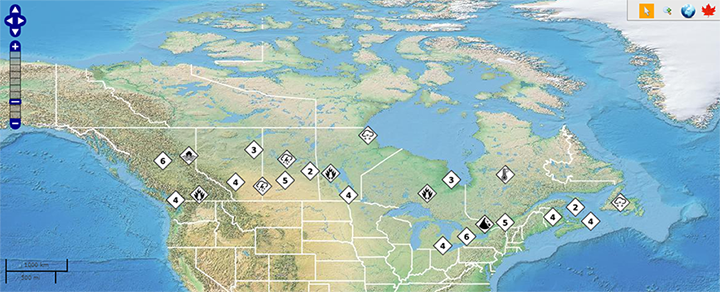Icebergs, sea ice and fog
Much of Canada's coastline has permanent or seasonal sea ice. Like icebergs, but less so, sea ice can be a hazard to offshore structures, fishing and navigation. It can be either fast ice, which stays close to shore, or drift ice, which moves around and grinds together with great force to form ridges.
The Arctic Ocean around the North Pole is covered with permanent sea ice. Each winter, the arctic ice pack expands as temperatures plummet. In some years, on the Atlantic side, the ice pack barely reaches the northernmost corner of Labrador. In other years, it can extend southeast of Newfoundland. Environment Canada monitors the ice pack through satellites (Radarsat), coastal climate stations and reconnaissance flights -- charting both where the ice is and estimating where it will move.
Fog is another ocean hazard. Found near the surface of land or water, this dense mass of water droplets threatens transportation of any kind. The worst maritime disaster in Canadian history was the fog-related collision in May, 1914 between the Canadian Pacific's Empress of Ireland and the Norwegian coal ship Storstadt in the St. Lawrence River near Rimouski, Quebec. More than 1,000 people died. The Empress of Ireland's Captain, H.G. Kendall, told an inquest that he had brought his ship to a halt and was waiting for clearer weather when, to his horror, another ship emerged from the fog, bearing directly upon him less than a ship's length away.
Fog forms when warm humid air is cooled below its dew point, the temperature at which water vapour condenses to form water droplets. Off the Atlantic coast, warm air masses moving north with the Gulf Stream are cooled when they encounter the cold Labrador Current, producing dense fogs along the Grand Banks off Newfoundland and south of Nova Scotia. As the air mass is cooled from below, a strong inversion is created (colder air is trapped below the warmer air) causing the fog to persist.
The ocean holds many dangers for ships and mariners
The Atlantic fog season reaches its maximum in July. Over the Pacific Ocean, this kind of fog is less common because the temperature difference between air mass and ocean temperature is not as great. Fog typically blows over adjacent land at night, burning off during the day.
Radar and the International Ice Patrol make sea travel safer than when the Titanic went down. But icebergs still threaten offshore oilrigs, fishing boats and ships. In July 1981, the 900-tonne Canadian survey ship Arctic Explorer struck an iceberg off Newfoundland and sank in 20 minutes. Thirteen crewmen died and 19 others drifted for two days in a life raft. These icebergs begin as large chunks. Up to 40,000 per year are "calved" off the Greenland icecap. They may tower 90 metres above the waves even though eight-ninths of their size is underwater. They float southward in the Labrador Current, reaching Newfoundland two to three years later if they have not melted or grounded in shallow water. It is unusual for icebergs to persist south of Newfoundland, due to the warmer temperatures.
For further information on specific events, see the Canadian Disaster Database.
To learn more about how individuals can get better prepared to cope with natural hazards, check out the information available from GetPrepared.
Emergency Management News Releases
Emergency Management Publications and Reports
- Government of Canada Response to the Public Order Emergency Commission Recommendations
- Advancing the Federal-Provincial-Territorial Emergency Management Strategy: Areas for Action
- Evaluation of the Initiatives to Address Post-Traumatic Stress Injuries (PTSI) Evaluation Report
- Summary of the Evaluation of the Initiatives to Address Post-Traumatic Stress Injuries (PTSI) Among Public Safety Officers
- The First Public Report of the National Risk Profile
- Date modified:
